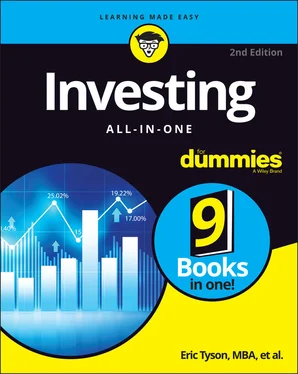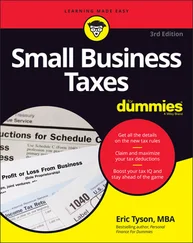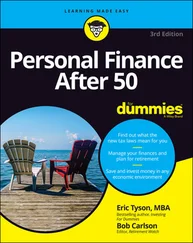Eric Tyson - Investing All-in-One For Dummies
Здесь есть возможность читать онлайн «Eric Tyson - Investing All-in-One For Dummies» — ознакомительный отрывок электронной книги совершенно бесплатно, а после прочтения отрывка купить полную версию. В некоторых случаях можно слушать аудио, скачать через торрент в формате fb2 и присутствует краткое содержание. Жанр: unrecognised, на английском языке. Описание произведения, (предисловие) а так же отзывы посетителей доступны на портале библиотеки ЛибКат.
- Название:Investing All-in-One For Dummies
- Автор:
- Жанр:
- Год:неизвестен
- ISBN:нет данных
- Рейтинг книги:3 / 5. Голосов: 1
-
Избранное:Добавить в избранное
- Отзывы:
-
Ваша оценка:
- 60
- 1
- 2
- 3
- 4
- 5
Investing All-in-One For Dummies: краткое содержание, описание и аннотация
Предлагаем к чтению аннотацию, описание, краткое содержание или предисловие (зависит от того, что написал сам автор книги «Investing All-in-One For Dummies»). Если вы не нашли необходимую информацию о книге — напишите в комментариях, мы постараемся отыскать её.
Investing All-in-One For Dummies
.
Dummies
Investing All-in-One For Dummies
Investing All-in-One For Dummies
Investing All-in-One For Dummies — читать онлайн ознакомительный отрывок
Ниже представлен текст книги, разбитый по страницам. Система сохранения места последней прочитанной страницы, позволяет с удобством читать онлайн бесплатно книгу «Investing All-in-One For Dummies», без необходимости каждый раз заново искать на чём Вы остановились. Поставьте закладку, и сможете в любой момент перейти на страницу, на которой закончили чтение.
Интервал:
Закладка:
Consider what has happened to the U.S. population over the past two centuries. In 1800, a mere 5 million people lived within U.S. borders. In 1900, that figure grew to 76.1 million, and today, it’s more than 330 million. All these people need places to live, and as long as jobs exist, the income from jobs largely fuels the demand for housing.
Businesses and people have an understandable tendency to cluster in major cities and suburban towns. Although some people commute, most people and businesses locate near major highways, airports, and so on. Thus, real estate prices in and near major metropolises and suburbs generally appreciate the most. Consider the areas of the world that have some of the most expensive real estate prices: Singapore, Hong Kong, Vancouver, San Francisco, Los Angeles, New York, and Boston. What these areas have in common are lots of businesses and people and limited land.
Contrast these areas with the many rural parts of the United States where the price of real estate is relatively low because of the abundant supply of buildable land and the relatively lower demand for housing.
Compounding Your Returns
During the past century, stocks and investment real estate returned around 9 percent per year, bonds around 5 percent, and savings accounts about 3 percent.
In case you’re curious about some alternative investments like gold and currencies, here are those numbers. Gold has just kept investors up with inflation with a tiny bit to spare — returning an average of about 0.5 percent per year after inflation. Currencies like the U.S. dollar have depreciated about 1.5 percent per year adjusting for inflation.
This section illustrates how compounding seemingly modest investment returns can help you accumulate a substantial sum of money to help you accomplish your personal and financial goals.
The value of getting a few extra percent
As discussed earlier in this chapter, investing in the stock market (and real estate) can be risky, which logically raises the question of whether investing in stocks and real estate is worth the anxiety and potential losses. Why bother for a few extra percent per year?
Here’s a good answer to that sensible question: Over many years, a few extra percent per year will increase your nest egg dramatically. The more years you have to invest, the greater the difference a few percent makes in your returns (see Table 2-3).
These numbers are simply amazing! Start first with the 25-year column in Table 2-3. For every $1,000 invested over 25 years, you’ll have $1,282 at a 1 percent annual return. At a 9 percent return, you’ll have $8,623, or nearly seven times as much!
TABLE 2-3How Compounding Grows Your Investment Dollars
| For Every $1,000 Invested at This Return | In 25 Years | In 40 Years |
|---|---|---|
| 1% | $1,282 | $1,489 |
| 2% | $1,641 | $2,208 |
| 3% | $2,094 | $3,262 |
| 4% | $2,666 | $4,801 |
| 5% | $3,386 | $7,040 |
| 6% | $4,292 | $10,286 |
| 7% | $5,427 | $14,974 |
| 8% | $6,848 | $21,725 |
| 9% | $8,623 | $31,409 |
Now look at what happens over 40 years. At a 9 percent investment return, you’ll have more than 21 times as much money versus what you’d have with a 1 percent annual investment return.
Here’s a practical example to show you what a dramatic difference earning a few extra percent can make in accomplishing your financial goals. Consider a 30-year-old investor who’s saving toward financial independence/retirement on a $60,000 annual salary. Suppose that their goal is to retire by age 67 with about $45,000 per year to live on (in today’s dollars), which would be about 75 percent of the investor’s working salary.
If this person begins saving at age 30, they need to save about $690 per month if you assume that they earn an average return on investments of about 5 percent per year. That’s a big chunk to save each year (about $8,300) — amounting to about 14 percent of gross (pretax) salary.
But what if this investor can earn an average return of just a few percent more per year — 8 percent instead of just 5 percent? In that case, the same goal could be accomplished by saving just half as much: $345 per month (or $4,150 per year)!
Considering your goals
How much do you need or want to earn on your investments?
You have to balance your goals with how you feel about risk. Some people can’t handle higher-risk investments. Although investing in stocks, real estate, or small business can produce high long-term returns, investing in these vehicles comes with greater risk, especially over the short term.
Others are at a time in their lives when they can’t afford to take great risk. If you’re still in school, if you’ve lost your job, or if you’re starting a family, your portfolio and nerves may not be able to wait a decade for your riskier investments to recover after a major stumble.
If you work for a living, odds are that you need and want to make your investments grow at a healthy clip. Should your investments grow slowly, you may fall short of your goals of owning a home or retiring or changing careers. All this is to say that you should take the time to contemplate and prioritize your personal and financial goals.
Chapter 3
The Workings of Stock and Bond Markets
IN THIS CHAPTER
 Going from a private to public company
Going from a private to public company
 Looking at the workings of the stock and bond markets and the economy
Looking at the workings of the stock and bond markets and the economy
 Deciphering interest rates, inflation, and the Federal Reserve
Deciphering interest rates, inflation, and the Federal Reserve
To buy and enjoy using a computer or smartphone, you don’t need to know the intricacies of how each device is put together and how it works. The same holds true for investing in stocks and bonds. However, spending some time understanding how and why the financial markets function may make you more comfortable with investing and make you a better investor.
This chapter explains the ways that companies raise capital, and you get a brief primer on financial markets and economics so you can understand and be comfortable with investing in the financial markets.
How Companies Raise Money through the Financial Markets
All businesses start small — whether they begin in a garage, a spare bedroom, or a rented office. As companies begin to grow, they often need more money (known as capital in the financial world) to expand and afford their growing needs, such as hiring more employees, buying computer systems, and purchasing other equipment.
Many smaller companies rely on banks to lend them money, but growing and successful firms have other options, too, in the financial markets. Companies can choose between two major money-raising options when they go into the financial markets: issuing stocks and issuing bonds.
Deciding whether to issue stocks or bonds
 A world of difference exists between the two major types of securities, both from the perspective of the investor and from that of the issuing company:
A world of difference exists between the two major types of securities, both from the perspective of the investor and from that of the issuing company:
Интервал:
Закладка:
Похожие книги на «Investing All-in-One For Dummies»
Представляем Вашему вниманию похожие книги на «Investing All-in-One For Dummies» списком для выбора. Мы отобрали схожую по названию и смыслу литературу в надежде предоставить читателям больше вариантов отыскать новые, интересные, ещё непрочитанные произведения.
Обсуждение, отзывы о книге «Investing All-in-One For Dummies» и просто собственные мнения читателей. Оставьте ваши комментарии, напишите, что Вы думаете о произведении, его смысле или главных героях. Укажите что конкретно понравилось, а что нет, и почему Вы так считаете.












